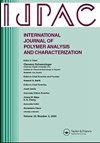High-performance biodegradable triboelectric nanogenerators using CoFe2O4 filled poly (butylene adipate-co-terephthalate)
IF 1.6
4区 工程技术
Q4 POLYMER SCIENCE
International Journal of Polymer Analysis and Characterization
Pub Date : 2024-10-14
DOI:10.1080/1023666X.2024.2410762
引用次数: 0
Abstract
The hunt for sustainable and efficient energy harvesting and storage devices has driven significant interest in triboelectric nanogenerators (TENGs) as potential alternatives to traditional batteries for powering electronic devices. However, the development of biodegradable TENGs remains a formidable challenge. This study presents the preparation of a tribopositive material entirely composed of biodegradable poly(butylene adipate-co-terephthalate) (PBAT) polymer enhanced with CoFe2O4 (CF) nanoparticles. The CF nanoparticles, synthesized via the combustion method, were incorporated into the PBAT matrix through solvent casting to form films with varied filler content (0.2, 0.4, 0.6, 0.8, and 1 g). The CF nanoparticles structural, surface, and electrical properties were characterized using XRD and FTIR spectroscopy. At the same time, the morphology of the nanomaterials and their composites was analyzed by scanning electron microscopy. Specifically, the 0.8 g PBAT-CF TENG demonstrated superior performance, achieving an output voltage of 45.45 V and a current of 4.5 µA. Subsequent electrical studies, including charging commercial capacitors (1.0 to 47 μF) and powering LEDs and calculators, underscored the device’s efficiency. The PBAT-CF TENG also effectively generated voltage and current signals from physical activities like walking and jumping. This innovative approach highlights the potential for biodegradable, high-performing, self-powered flexible electronics, and wearable devices, paving the way for sustainable technological advancements.
使用 CoFe2O4 填充聚(己二酸丁二醇酯-对苯二甲酸乙二醇酯)的高性能可生物降解三电纳米发电机
对可持续和高效能源采集和存储设备的追求,促使人们对三电纳米发电机(TENGs)产生了浓厚的兴趣,并将其作为传统电池的潜在替代品,为电子设备供电。然而,开发可生物降解的 TENGs 仍然是一项艰巨的挑战。本研究介绍了一种完全由可生物降解的聚己二酸丁二醇酯(PBAT)聚合物和 CoFe2O4(CF)纳米颗粒组成的摩擦正极材料的制备方法。通过燃烧法合成的 CF 纳米粒子通过溶剂浇铸法加入到 PBAT 基质中,形成不同填料含量(0.2、0.4、0.6、0.8 和 1 克)的薄膜。利用 XRD 和傅立叶变换红外光谱对 CF 纳米粒子的结构、表面和电学特性进行了表征。同时,利用扫描电子显微镜分析了纳米材料及其复合材料的形态。具体而言,0.8 克 PBAT-CF TENG 表现出卓越的性能,输出电压达到 45.45 V,电流为 4.5 µA。随后进行的电学研究,包括为商用电容器(1.0 至 47 μF)充电以及为 LED 和计算器供电,都凸显了该器件的效率。PBAT-CF TENG 还能有效地从步行和跳跃等身体活动中产生电压和电流信号。这种创新方法凸显了可生物降解、高性能、自供电柔性电子器件和可穿戴设备的潜力,为可持续技术进步铺平了道路。
本文章由计算机程序翻译,如有差异,请以英文原文为准。
求助全文
约1分钟内获得全文
求助全文
来源期刊
CiteScore
3.50
自引率
5.30%
发文量
37
审稿时长
1.6 months
期刊介绍:
The scope of the journal is to publish original contributions and reviews on studies, methodologies, instrumentation, and applications involving the analysis and characterization of polymers and polymeric-based materials, including synthetic polymers, blends, composites, fibers, coatings, supramolecular structures, polysaccharides, and biopolymers. The Journal will accept papers and review articles on the following topics and research areas involving fundamental and applied studies of polymer analysis and characterization:
Characterization and analysis of new and existing polymers and polymeric-based materials.
Design and evaluation of analytical instrumentation and physical testing equipment.
Determination of molecular weight, size, conformation, branching, cross-linking, chemical structure, and sequence distribution.
Using separation, spectroscopic, and scattering techniques.
Surface characterization of polymeric materials.
Measurement of solution and bulk properties and behavior of polymers.
Studies involving structure-property-processing relationships, and polymer aging.
Analysis of oligomeric materials.
Analysis of polymer additives and decomposition products.

 求助内容:
求助内容: 应助结果提醒方式:
应助结果提醒方式:


